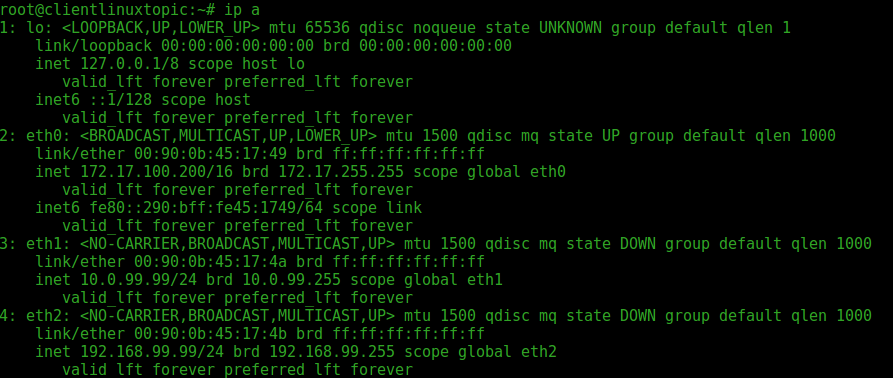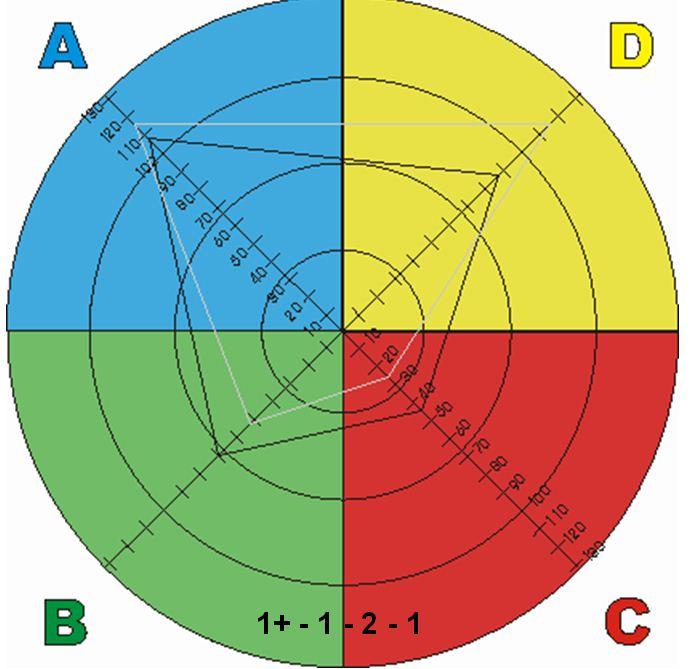
On CentOS / RHEL 7 / Fedora 19+ and other Linux distributions, the default network eth0, eth1 .. interface naming scheme has been changed and in newer Linux kernels OS-es to names such as – ens3 , eno1, enp5s2, em1 etc., well known old scheme for eth* is now considered a legacy.
This new Network card naming in Linux OS is due to changes made in Kernel / modules and udev rules which resembles how Ethernet ifaces are named on other UNIX like systems.
The weird name is taken depending on the Hardware Network card vendor name and is a standard for years in FreeBSD and Mac OSX, however this was not so over the years,
so for old school sysadmins that's pretty annoying as, we're much used to the eth0 / eth1 / eth2 / eth3 naming standard which brought some clearness on the network card naming.
Also for systems which are upgraded from old Linux OS distro releases to a newer ones, that includes this great new "cool" feature, that fits so well the New age-of computing Cloud craziness.
That behaviour could create a number of problems, especially if the already Production working servers due to failure to bring up some of the network devices after the upgrade or, even if you fix that by editting the /etc/network* / etc/sysconfig/networking/* by hand still there is even more stuff that won't work properly, such as any custom made iptables / ipset firewalls rules, or any kind of custom used third party Shell / Perl scripts that depend on the old-school conventional and (convenient easy to remember!!!) eth0, eth2 etc. naming.
For sysadmins who are using some kind of Application Clustering with something like corosync / pacemaker this new fuzzy improvement makes things even worse as having a changed interface name of the card will break the cluster …
1. Get list of the LAN Card Server hardware
To get a better view on the server installed and recognized LAN Cards use lspci / dmidecode commands:
lspci |grep -i Ether -A1 -B1
01:00.4 USB controller: Hewlett-Packard Company Integrated Lights-Out Standard Virtual USB Controller (r ev 03)
02:00.0 Ethernet controller: Broadcom Inc. and subsidiaries NetXtreme BCM5719 Gigabit Ethernet PCIe (rev 01)
02:00.1 Ethernet controller: Broadcom Inc. and subsidiaries NetXtreme BCM5719 Gigabit Ethernet PCIe (rev 01)
02:00.2 Ethernet controller: Broadcom Inc. and subsidiaries NetXtreme BCM5719 Gigabit Ethernet PCIe (rev 01)
02:00.3 Ethernet controller: Broadcom Inc. and subsidiaries NetXtreme BCM5719 Gigabit Ethernet PCIe (rev 01)
03:00.0 RAID bus controller: Hewlett-Packard Company Smart Array Gen9 Controllers (rev 01)
05:00.0 Ethernet controller: Broadcom Inc. and subsidiaries NetXtreme BCM5719 Gigabit Ethernet PCIe (rev 01)
05:00.1 Ethernet controller: Broadcom Inc. and subsidiaries NetXtreme BCM5719 Gigabit Ethernet PCIe (rev 01)
05:00.2 Ethernet controller: Broadcom Inc. and subsidiaries NetXtreme BCM5719 Gigabit Ethernet PCIe (rev 01)
05:00.3 Ethernet controller: Broadcom Inc. and subsidiaries NetXtreme BCM5719 Gigabit Ethernet PCIe (rev 01)
7f:08.0 System peripheral: Intel Corporation Xeon E7 v3/Xeon E5 v3/Core i7 QPI Link 0 (rev 02)
lspci reports all attached LAN Cards to server which are plugged in on the Motherbord, since that specific server has a Motherboard integrated LAN Adapters too, we can see this one
via dmidecode.
# dmidecode |grep -i Ether -A 5 -B 5
Handle 0x00C5, DMI type 41, 11 bytes
Onboard Device
Reference Designation: Embedded LOM 1 Port 3
Type: Ethernet
Status: Enabled
Type Instance: 3
Bus Address: 0000:XX:00.XHandle 0x00C6, DMI type 41, 11 bytes
Onboard Device
Reference Designation: Embedded LOM 1 Port 4
Type: Ethernet
Status: Enabled
Type Instance: 4
Bus Address: 0000:0X:00.XHandle 0x00C7, DMI type 41, 11 bytes
—
…
Strings:
PciRoot(0x0)/Pci(0x2,0x0)/Pci(0x0,0x0)
NIC.Slot.2.1
HP Ethernet 1Gb 4-port 331T Adapter – NIC
Slot 2Handle 0x00E3, DMI type 203, 34 bytes
OEM-specific Type
Header and Data:
—
…
The illustrate the eth0 changing name issue, here is example taken from server on how eth1 interface is named on a new CentOS install:
# ip addr show
…..
eno1: [BROADCAST,MULTICAST,UP,LOWER_UP] mtu 1500 qdisc pfifo_fast state UP qlen 1000
link/ether 6c:0b:84:6c:48:1c brd ff:ff:ff:ff:ff:ff
inet 10.10.9.5/24 brd 10.10.9.255 scope global eno1
inet6 2606:b400:c00:48:6e0b:84ff:fe6c:481c/128 scope global dynamic
valid_lft 2326384sec preferred_lft 339184sec
inet6 fe80::6e0b:84ff:fe6c:481c/64 scope link
valid_lft forever preferred_lft forever
2. Disable Network Manager on the server
To prevent potential problems for future with randomly changing Network card names order on reboots and other mess,
it is generally a good idea to disable Network Manager.
# systemctl disable NetworkManager
rm '/etc/systemd/system/multi-user.target.wants/NetworkManager.service'
rm '/etc/systemd/system/dbus-org.freedesktop.NetworkManager.service'
rm '/etc/systemd/system/dbus-org.freedesktop.nm-dispatcher.service'
3. Check and correct network configuration if necessery in /etc/sysconfig/network-scripts/ifcfg-*
Either fix the naming across all files ifcfg-* to match eth0 / eth1 / ethXX or even better both change the NAME and DEVICE in files and completely rename the files ifcfg-eno1 to ifcfg-eth1 ..
ifcfg-enoXX to ifcfg-ethXX
server:~# cat /etc/sysconfig/network-scripts/ifcfg-eno1
……
NAME=eth0
DEVICE=eth0
……
4. Fix the interface scheme naming through passing a GRUB boot parameter to Kernel
a. Create backup of /etc/default/grub
cp -rpf /etc/default/grub /etc/default/grub_bak_date +"%Y_%m_%Y"
b. Edit /etc/default/grub
c. Find config parameter GRUB_CMDLINE_LINUX
d. Add net.ifnames=0 biosdevname=0 to the line
net.ifnames=0 biosdevname=0
After the change the line should look like
GRUB_CMDLINE_LINUX=" crashkernel=auto net.ifnames=0 biosdevname=0 rhgb quiet"
e. Regenerate GRUB loader to have included the new config
server:~# grub2-mkconfig -o /boot/grub2/grub.cfg
f. Reboot the sytem
server:~# shutdown -r now
5. Fix auto-generated inconvenient naming by modifying udev rules
The Mellanox Ehternet server card vendor's workaround to the ever changing eth names is modify udev rules to be able to have the ordinary eth0 / eth1 / eth2 … Lan card name scheme.
In short this is recommended for Mellanox but should work on any other Lan card device attached on a Linux powered server.
# cat /etc/sysconfig/network-scripts/ifcfg-eth1
DEVICE="eth1"
BOOTPROTO="static"
HWADDR="7c:fe:90:cb:76:02"
IPADDR=10.10.9.2
NETMASK=255.255.255.0
ONBOOT="yes"
# cat /etc/sysconfig/network-scripts/ifcfg-eth2
DEVICE="eth1"
BOOTPROTO="static"
HWADDR="7c:fe:90:cb:76:02"
IPADDR=10.10.99.99
NETMASK=255.255.255.0
ONBOOT="yes"
# vi /etc/udev/rules.d/70-persistent-net.rules
SUBSYSTEM=="net", ACTION=="add", DRIVERS=="?*", ATTR{address}=="7c:fe:90:cb:76:02", ATTR{dev_id}=="0x0", ATTR{type}=="1", KERNEL=="eth*", NAME="eth1"
SUBSYSTEM=="net", ACTION=="add", DRIVERS=="?*", ATTR{address}=="7c:fe:90:cb:76:03", ATTR{dev_id}=="0x0", ATTR{type}=="1", KERNEL=="eth*", NAME="eth2"
Next step is to reboot.
# /sbin/reboot
After a while when the server boots check with ip or ifconfig the configuration to make sure the ethXX ordering is proper again.

# /sbin/ifconfig eth1
eth1: flags=4163<UP,BROADCAST,RUNNING,MULTICAST> mtu 1500
inet 10.0.99.99 netmask 255.255.255.0 broadcast 10.10.9.255
inet6 fe80::7efe:90ff:fecb:7602 prefixlen 64 scopeid 0x20<link>
ether 7c:fe:90:cb:76:02 txqueuelen 1000 (Ethernet)
RX packets 0 bytes 0 (0.0 B)
RX errors 0 dropped 0 overruns 0 frame 0
TX packets 23 bytes 3208 (3.1 KiB)
TX errors 0 dropped 0 overruns 0 carrier 0 collisions 0
eth2: flags=4099<UP,BROADCAST,MULTICAST> mtu 1500
ether 7c:fe:90:cb:76:03 txqueuelen 1000 (Ethernet)
RX packets 0 bytes 0 (0.0 B)
RX errors 0 dropped 0 overruns 0 frame 0
TX packets 0 bytes 0 (0.0 B)
TX errors 0 dropped 0 overruns 0 carrier 0 collisions 0
On some Linux distributions, if it happens this udev extra configuration is not venerated, use net.ifnames=0 biosdevname=0 grub configuration.
6. Verify eth interfaces are present
# ip addr show
…..
eth0: [BROADCAST,MULTICAST,UP,LOWER_UP] mtu 1500 qdisc pfifo_fast state UP qlen 1000
link/ether 6c:0b:84:6c:48:1c brd ff:ff:ff:ff:ff:ff
inet 10.10.9.5/24 brd 10.10.9.255 scope global eno1
inet6 2606:b400:c00:48:6e0b:84ff:fe6c:481c/128 scope global dynamic
valid_lft 2326384sec preferred_lft 339184sec
inet6 fe80::6e0b:84ff:fe6c:481c/64 scope link
valid_lft forever preferred_lft forever
That's all this should put an end to the annoying auto generated naming lan device naming.
Summary
So what was explained up was how to resolve problems caused by autogenerated ethernet interface cards by a new functionality in the Linux kernel, so Network cards are again visible via ip address show / ifconfig again in a proper order eth0 / eth1 / eth2 / eth3 etc. instead of a vendor generated cryptic names as ens / eno / em etc. This is possible via either by editing udev rules or grub configuration. Doing so saves nerves and makes sysadmin life better, at least it did mine.
That's all this should put an end to the annoying auto generated naming.














